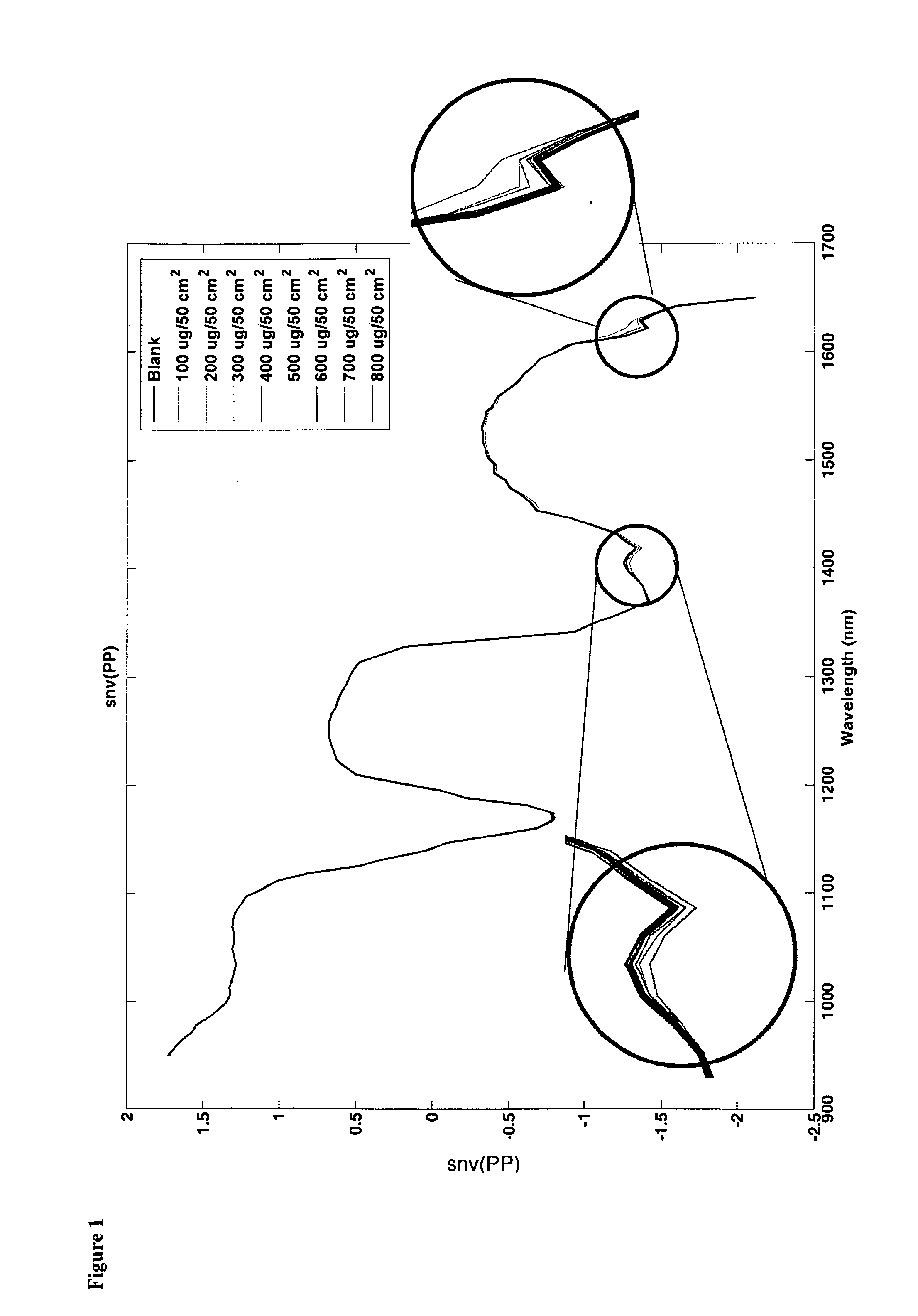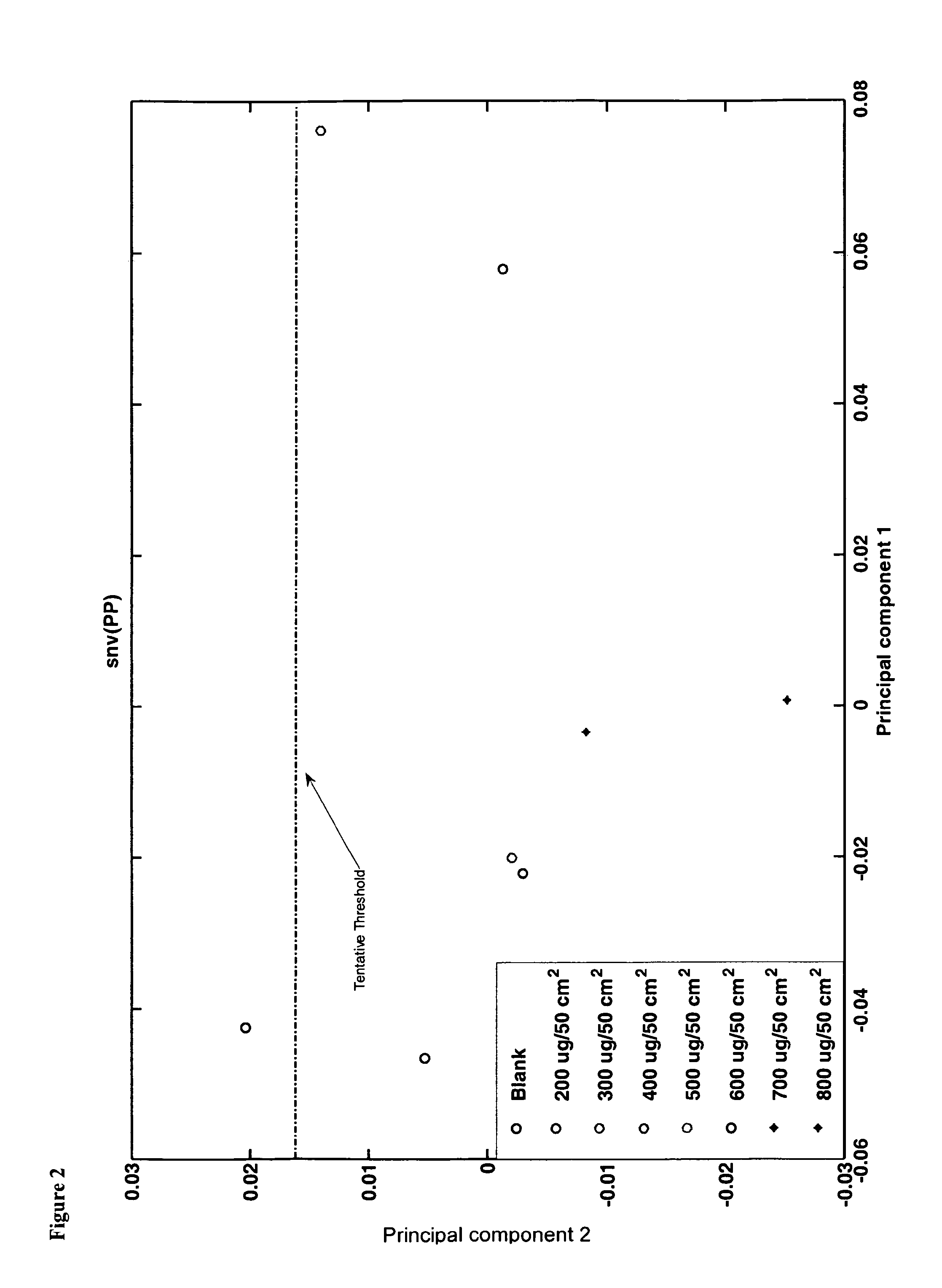Method of validating a cleaning process
a cleaning process and validation method technology, applied in the field of spectroscopic evaluation of a substance or product on a surface, can solve problems such as manufacturing downtime, equipment cannot be used, drawbacks and challenges
- Summary
- Abstract
- Description
- Claims
- Application Information
AI Technical Summary
Benefits of technology
Problems solved by technology
Method used
Image
Examples
example 1
[0125]The first experiment carried out was with a lactose sample in a water and alcohol dilution series, which was placed on 10 cm×10 cm perspex coupon.
Materials and Methods
Solution
[0126]0.1000 g of lactose was dissolved in 20 ml of water and mixed with 80 ml of ethanol.
Coupon Preparation
[0127]Coupons were washed with hot water and dried[0128]Blank was sprayed twice with a 80% ethanol solution and left dry[0129]Concentrations C1 to C8 were achieve by successive cycles of spraying lactose solution over the coupon and drying, i.e. once to C1, twice to C2, three time to C3, . . . , and eight times to C8.[0130]Hyperspectral images were acquired.[0131]Data analysis
[0132]Concentration over the coupon was estimated according with the following equation:
Concentration(μg50cm2)=d*b*e*50c*a
aCoupon100cm{circumflex over ( )}2AreabFactor0.5cDensity0.8g / mldEach spray0.332gmasseSolution1000g / mlconcentration
[0133]Cleaning validation coupons, 316 stainless steel, #4 finish, 10 cm×10 cm SS316-#4
[0134]...
example 2
[0136]The second experiment carried out was with a lactose sample in a water and alcohol dilution series, which was placed on 10 cm×10 cm stainless steel coupon.
Results
[0137]There was an identifiable peak present at 1340 and 1620 nm as illustrated by FIG. 3. Both peaks appeared to exhibit an increase in strength as the concentration of the sample increased. There was excellent separation of spectra per concentration sample. This study confirms the ability of the technology used in the method of the invention to quantify lactose concentrations as low as 100 ug / 100 cm2 from Stainless Steel material. Such results are difficult to achieve using prior art methods due to low signal to noise issued on steel. FIG. 4 illustrates the principle component score plot of Standard Normal Variate (SNV) of reflectance spectra for lactose on stainless steel.
Conclusion
[0138]In conclusion, the experimental work was successful in confirming that NIR-CI used in the method of the invention is an appropria...
example 3
[0139]This experiment was carried out using a lactose sample in an alcohol dilution series, which was placed on 2 cm×2 cm stainless steel tiles.
Materials and Methods
[0140]1) Dilute series of lactose samples in alcohol.[0141]5 g lactose in 50 ml water or 10% dilution. Then dilute down into a 5%, 2.5% and 1.25% dilution.[0142]2) Pipette dilutions onto the stainless steel slides in 0.1 ml samples.[0143]3) Air dry slides.[0144]4) Remove slides and scan to get the spectra for the lactose.[0145]5) Obtain hyperspectral images using a pushbroom line-scanning HSI instrument (DV Optics Ltd., Padua, Italy), operating in the NIR (950-1700 nm) wavelength range.
Results
[0146]A variance was identified in the spectra of samples, which should have given uniform spectra (FIG. 7). There was also a variance in the background spectra, as illustrated by FIG. 6. These variances were down to the fact that the stainless steel tiles were all separate and the cut edges of the stainless steel were giving off sl...
PUM
 Login to View More
Login to View More Abstract
Description
Claims
Application Information
 Login to View More
Login to View More - R&D
- Intellectual Property
- Life Sciences
- Materials
- Tech Scout
- Unparalleled Data Quality
- Higher Quality Content
- 60% Fewer Hallucinations
Browse by: Latest US Patents, China's latest patents, Technical Efficacy Thesaurus, Application Domain, Technology Topic, Popular Technical Reports.
© 2025 PatSnap. All rights reserved.Legal|Privacy policy|Modern Slavery Act Transparency Statement|Sitemap|About US| Contact US: help@patsnap.com



